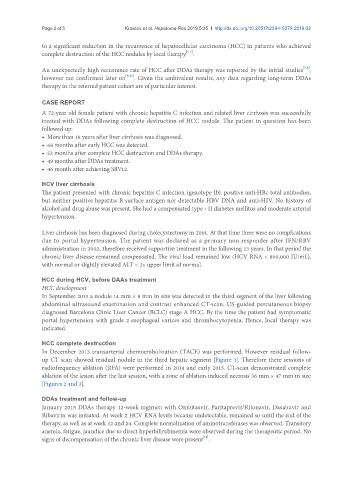Page 355 - Read Online
P. 355
Page 2 of 5 Krastev et al. Hepatoma Res 2019;5:35 I http://dx.doi.org/10.20517/2394-5079.2019.02
to a significant reduction in the recurrence of hepatocellular carcinoma (HCC) in patients who achieved
[4-6]
complete destruction of the HCC nodules by local therapy .
[7,8]
An unexpectedly high recurrence rate of HCC after DDAs therapy was reported by the initial studies ,
however not confirmed later on [9,10] . Given the ambivalent results, any data regarding long-term DDAs
therapy in the referred patient cohort are of particular interest.
CASE REPORT
A 72-year old female patient with chronic hepatitis C infection and related liver cirrhosis was successfully
treated with DDAs following complete destruction of HCC nodule. The patient in question has been
followed-up:
• More than 18 years after liver cirrhosis was diagnosed.
• 68 months after early HCC was detected.
• 52 months after complete HCC destruction and DDAs therapy.
• 49 months after DDAs treatment.
• 46 month after achieving SRV12.
HCV liver cirrhosis
The patient presented with chronic hepatitis C infection (genotype Ib), positive anti-HBc total antibodies,
but neither positive hepatitis B surface antigen nor detectable HBV DNA and anti-HIV. No history of
alcohol and drug abuse was present. She had a compensated type - II diabetes mellitus and moderate arterial
hypertension.
Liver cirrhosis has been diagnosed during cholecystectomy in 2001. At that time there were no complications
due to portal hypertension. The patient was declared as a primary non-responder after IFN/RBV
administration in 2002, therefore received supportive treatment in the following 13 years. In that period the
chronic liver disease remained compensated. The viral load remained low (HCV RNA < 800,000 IU/mL),
with normal or slightly elevated ALT < 2× upper limit of normal.
HCC during HCV, before DAAs treatment
HCC development
In September 2013 a nodule 14 mm × 8 mm in size was detected in the third segment of the liver following
abdominal ultrasound examination and contrast enhanced CT-scan. US-guided percutaneous biopsy
diagnosed Barcelona Clinic Liver Cancer (BCLC) stage A HCC. By the time the patient had symptomatic
portal hypertension with grade 2 esophageal varices and thrombocytopenia. Hence, local therapy was
indicated.
HCC complete destruction
In December 2013 transarterial chemoembolization (TACE) was performed. However residual follow-
up CT scan showed residual nodule in the third hepatic segment [Figure 1]. Therefore there sessions of
radiofrequency ablation (RFA) were performed in 2014 and early 2015. CT-scan demonstrated complete
ablation of the lesion after the last session, with a zone of ablation-induced necrosis 36 mm × 47 mm in size
[Figures 2 and 3].
DDAs treatment and follow-up
January 2015 DDAs therapy 12-week regimen with Ombitasvir, Paritaprevir/Ritonavir, Dasabuvir and
Ribavirin was initiated. At week 2 HCV RNA levels became undetectable, remained so until the end of the
therapy, as well as at week 12 and 24. Complete normalization of aminotransferases was observed. Transitory
anemia, fatigue, jaundice due to direct hyperbilirubinemia were observed during the therapeutic period. No
[11]
signs of decompensation of the chronic liver disease were present .

